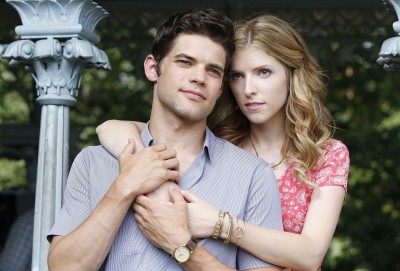
Musical theatre actors are often forced into classes along the lines of “acting the song.” They choose a piece that shows off their highest range, something like the modern classic “Defying Gravity” from “Wicked,” and they sing. And while they sing their tortured hearts out, they are supposed to — you guessed it — act.
Many people aren’t very good at this. Typically, it’s one of the major things that weeds people out at casting calls. This isn’t the case, though, for the two perfectly-cast stars of “The Last Five Years.” For new movie musical wunderkind Anna Kendrick and Broadway hunk Jeremy Jordan, it’s in fact the exact opposite.
Based on Jason Robert Brown’s 2002 off-Broadway show of the same name, the film tells the semi-autobiographical love story of up-and-coming writer Jamie Wellerstein, portrayed with vigor and poise by Jordan, and struggling actress Cathy Hiatt, played with pathos and beauty by Kendrick. The story unfolds almost entirely through song and rotates back and forth between their two perspectives over the five years of their relationship. Cathy begins her side of the story at the end, while Jamie starts at the beginning.
The struggle within Jamie and Cathy’s relationship quickly becomes apparent when Jamie is offered his first publishing deal while Cathy is still rejected at casting auditions. Who do you side with as the relationship deteriorates?
This question becomes even more complicated while watching Jordan and Kendrick take on their roles, as they are both so well executed. Jamie is the perfect amount of charming-yet-slimy. His swoon-worthy smile beckons you to root for him, but that starts to disappear with every deplorable decision he makes. On the other hand, Kendrick’s courageous Cathy is incredibly relatable as she struggles through God-awful Ohio summer stock productions like “Fiddler on the Roof,” but she becomes too whiney and stubborn when things don’t go her way, pushing the limits of her likeability. Kendrick’s performance is one of her best yet, far surpassing her turn in the vomitous “Pitch Perfect.”
The pull to waver when choosing sides, driven by an extremely delicate balance between compassion and contempt for the characters, lies at the heart of a lot of great drama. While most recent movie musicals have been flailing trainwrecks full of non-singers, terrible casting choices and sub-par scripts (I’m looking at you, “Les Misérables”), “The Last Five Years” is a truly loyal adaptation in this regard.
It is clear that this film was made for fans of the musical. This, unfortunately, makes the plot occasionally difficult to follow for someone who has never listened to the soundtrack before.
On the other hand, writer and director Richard LaGravenese allowed for Brown’s score to come to full fruition in a way that it had never been able to previously. In its stage form, “The Last Five Years” is a rotation in which Jamie and Cathy sing their songs individually, only coming together onstage during “The Next Ten Minutes,” their engagement and wedding montage. While mostly effective in delivering its message, the stage version lacks certain depth due to the fact that the two main characters simply do not interact. There is no partnering and no chemistry, certainly leaving something to be desired.
That’s easily and effectively remedied here. This story translates so well onto the screen. The ability to watch Jamie and Cathy’s reactions and exchanges are a huge benefit to the story’s emotional heft. Scenic elements, such as Jamie and Cathy’s apartment, also allow for more creative approaches to Brown’s lyrically intensive and descriptive songs. One of the best moments in the film, “The Schmuel Song,” is brought to comedic life in this way. The six-minute number, sung entirely by Jamie, tells the story of Schmuel, the “tailor of Klimovich” who worked to sew the perfect dress that would take him back 41 years to the time he had spent with a young girl from Odessa. With much trial and determination, Schmuel finally gets his wish.
Jamie uses Cathy’s sewing materials as props in Schmuel’s tailor shop, while simultaneously stringing Christmas lights into the rafters. As Jamie sings, he reveals that the Schmuel story is actually about Cathy, tying her sewing hobby we see throughout the film back into the fact that she can’t seem to get cast in a show. Seemingly, Jamie had tried this method with Cathy before — this scene is not the first time she has come angry from her bartending job — but his attempts to make her happy with Christmas lights and fairytales don’t seem to faze her. He advises her to “take a breath, take a step, take a chance,” just as Schmuel did. The story is told with such passion and honesty that you can almost feel your heart break for Jamie.
That the entire score for this film was sung live is an added bonus. It allowed for Jordan and Kendrick to truly connect to the work. Plus, it makes for a good snub to — again — Tom Hooper and his “Les Misérables” adaptation, which allowed an utterly terrible cast to do the same, basically butchering a blockbuster musical. Truly passionate musical fans will be thanking LaGravenese, Brown, Jordan and Kendrick for instead providing a wonderful adaptation that they can forever cherish.


























































































































